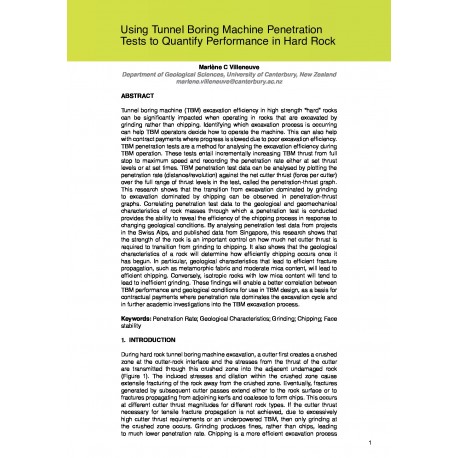Cart
0
0
No document
0,00 €
Total
Document successfully added to your shopping cart
Quantity
Total
There are 0 items in your cart.
There is 1 item in your cart.
Total documents
Total shipping
To be determined
Total
Search & filter
Search for a publication
Search & filter
Using Tunnel Boring Machine Penetration Tests to Quantify Performance in Hard Rock
250_using_tunnel_boring_machine_
Tunnel boring machine (TBM) excavation efficiency in high strength “hard” rocks can be significantly impacted when operating in rocks that are excavated by grinding rather than chipping. Identifying which excavation process is occurring can help TBM operators decide how to operate the machine. This can also help with contract payments where progress is slowed due to poor excavation efficiency. TBM penetration tests are a method for analysing the excavation efficiency during TBM operation. These tests entail incrementally increasing TBM thrust from full stop to maximum speed and recording the penetration rate either at set thrust levels or at set times. TBM penetration test data can be analysed by plotting the penetration rate (distance/revolution) against the net cutter thrust (force per cutter) over the full range of thrust levels in the test, called the penetration-thrust graph. This research shows that the transition from excavation dominated by grinding to excavation dominated by chipping can be observed in penetration-thrust graphs. Correlating penetration test data to the geological and geomechanical characteristics of rock masses through which a penetration test is conducted provides the ability to reveal the efficiency of the chipping process in response to changing geological conditions. By analysing penetration test data from projects in the Swiss Alps, and published data from Singapore, this research shows that the strength of the rock is an important control on how much net cutter thrust is required to transition from grinding to chipping. It also shows that the geological characteristics of a rock will determine how efficiently chipping occurs once it has begun. In particular, geological characteristics that lead to efficient fracture propagation, such as metamorphic fabric and moderate mica content, will lead to efficient chipping. Conversely, isotropic rocks with low mica content will tend to lead to inefficient grinding.




